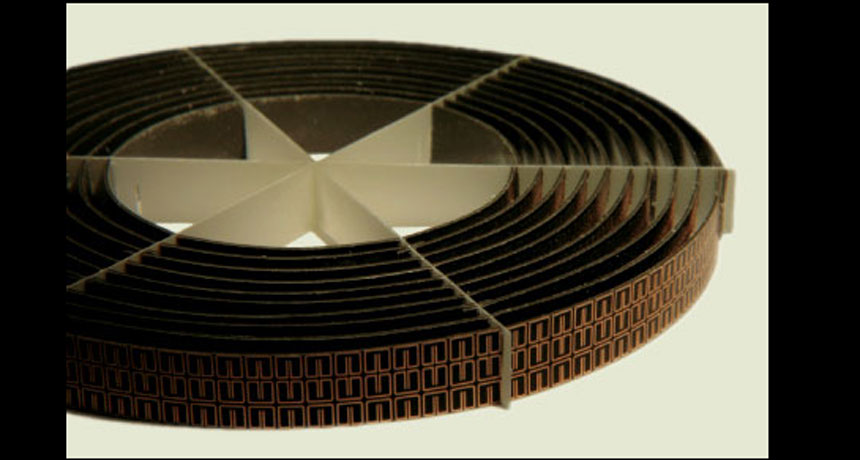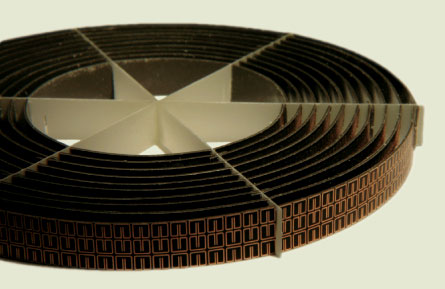The science of disappearing
Invisibility cloaks and other new materials that play with light are in the works

Less than half an inch tall and five inches across, this cloaking device was able to steer microwaves around it. The object to be hidden would be placed in the center.
Jack J. Mock, D. Smith Lab/Duke University
Imagine what you could do with a machine that could make things disappear.
For inspiration, you could hit the books: In Greek mythology, the goddess Athena wore an invisibility cap during the Trojan War. The same cap helped the half-god Perseus, who wore it to hide from Medusa, a monster who could turn someone to stone just by looking at them. In the books of J.R.R. Tolkein, Bilbo Baggins found a ring that could make him invisible; he passed it on to his nephew Frodo. And of course, there’s poor Harry Potter, who used his invisibility cloak to spy on classmates and teachers, hide from dragons or avoid certain spells cast on him by his enemies.
Now that you’ve got some ideas, it’s time for the hard part: building the cloak. To do that, you have to abandon science fiction and turn to real science. Two starting questions: How do you use visible materials to build something that’s supposed be invisible? How would you see it?
“If I were doing it, I’d built my invisibility device to have a remote control on/off switch,” says Steven Cummer, an engineer at Duke University in Durham, N.C. “This way I could have all of the pieces ‘off’ when it was being assembled. And if I lost track of it, I would have at least a chance of finding it by turning it off.”
Cummer has thought about this: In October 2006, Cummer was part of a team of scientists from Duke, including David R. Smith and David Schurig, who built the world’s first version of an invisibility cloak. They had been inspired by the work of a British physicist named John Pendry, who in May 2006 showed that an invisibility cloak was possible. And Pendry wasn’t the only one thinking about a disappearing act — at about the same time, a Scottish physicist named Ulf Leonhardt published a paper on building a cloaking device.
 |
|
Less than half an inch tall and five inches across, this cloaking device was able to steer microwaves around it. The object to be hidden would be placed in the center.
|
| Jack J. Mock, D. Smith Lab/Duke University |
It wasn’t easy or perfect, Cummer says. “As often happens in science and research, it didn’t work very well the first time. It took several redesigns before we built something that worked pretty well.”
The device didn’t much resemble a cloak — at least, not one you would wear. It looked more like a set of circular fences nested inside each other, with a place inside for the object to be hidden. But up close, if you had a powerful magnifying glass, you would see tiny metal circles and rods that made intricate patterns all over these fences. These small details are one reason why the cloak works.
The device was small, about 5 inches across (roughly the diameter of a CD). Plus, that first cloak didn’t work like Harry Potter’s — the scientists didn’t actually see anything disappear.
Of course, they hadn’t expected to. That first version of the invisibility cloak didn’t shield objects from visible light. Instead, it hid things from a type of radiation called microwaves.
Moving the microwaves
An invisibility cloak has to deceive anything or anyone who might be watching. In order to understand how something can be invisible, it’s important to understand how we see.
Human beings see only objects that reflect light waves. These waves enter the eye and then are processed by the brain. But if an object doesn’t reflect light, then the waves don’t enter the eye, and the brain doesn’t process. The challenge of building an invisibility cloak is to build something that does not reflect or in any way interrupt waves of light.
 |
|
Visible light has shorter wavelengths and higher frequencies than microwave radiation. So it will be harder to build a cloak that hides objects from visible light.
|
| NASA |
Light is a type of radiation, and all radiation travels in waves. Waves of radiation move through space somewhat as water waves do. And just as waves in the ocean have high points called crests and low points called troughs, radiation waves have crests and troughs. Unlike water waves, however, waves of radiation are made up of electric fields and magnetic fields that move together through space.
Scientists can learn a lot about a wave by measuring two things: its wavelength and its frequency. Wavelength is the distance from one crest to the next, and frequency is the number of waves that pass by a point in one second. Microwaves, for example, are more spread out than visible light — that means they have longer wavelengths and lower frequencies than visible light. (Microwave ovens, for example, heat food with microwaves that are about 13 centimeters, or about 5 inches, long.) In all kinds of radiation, frequency and wavelength are related — the higher the frequency, the shorter the wavelength. Waves of radiation differ by frequency and wavelength, and all the different types of waves together are called the “electromagnetic spectrum.”
At Duke, the engineers aimed microwave radiation at their device and took measurements. After the experiment, they looked at the data. According to their measurements, the device had shuffled the microwave radiation around the cylinder that is in the middle. Then, on the other side of the device, the waves had resumed their course — as though nothing had happened.
In other words, the waves of radiation moved around the device the way water waves move around a rock in the middle of a stream. Those tiny metal circles and rods were designed to change the directions of the electric and magnetic fields of the waves. By changing those fields in just the right way, the cloak could move the waves around itself.
Since that first successful test, in laboratories from North Carolina to California, Spain to Hong Kong, scientists have been racing to find ways to make invisibility a reality.
The Duke scientists made history with microwaves, but now scientists want to go further — and they are.
Last summer, for example, two independent teams of scientists announced they had created cloaks that worked for visible light. Unfortunately, those cloaks are tiny, so tiny that all they can hide are things so small that people already can’t see them. Plus, researchers have only redirected radiation that is at the far-red end of the electromagnetic spectrum — radiation with low frequency and long wavelengths.
Despite these problems, these breakthroughs are an important step forward in the science of disappearance and show that a cloak that can hide things from plain sight may not be far away.
Marvelous metamaterials
Invisibility cloaks would have remained impossible, forever locked in science fiction, had it not been for the development of metamaterials. In Greek, “meta” means beyond, and metamaterials can do things beyond what we see in the natural world — like shuffle light waves around an object, and then bring them back together. If scientists ever manage to build a full-fledged invisibility cloak, it will probably be made of metamaterials.
“We are creating materials that don’t exist in nature, and that have a physical phenomenon that doesn’t exist in nature,” says engineer Dentcho Genov. “That is the most exciting thing.” Genov designs and builds metamaterials — such as those used in cloaking — at Louisiana Tech University in Ruston, Louisiana.
An invisibility cloak will probably not be the first major accomplishment to come from the field of metamaterials. Other applications are just as exciting. In many labs, for example, scientists are working on building a hyperlens.
A lens is a device — usually made of glass — that can change the direction of light waves. Lenses are used in microscopes and cameras to focus light, thus allowing a researcher to see small things or a photographer to capture image of things that are far away.
A hyperlens, however, would be made of metamaterials. And since metamaterials can do things with light that ordinary materials can’t, the hyperlens would be a powerful tool. A hyperlens would allow researchers to see things at the smallest scale imaginable — as small as the wavelength of visible light.
Genov points out that the science of metamaterials is driven by the imagination: If someone can think of an idea for a new behavior for light, then the engineers can find a way to design a device using metamaterials. “We need people who can imagine,” he says.
Science of metamaterials just forming
The idea of invisibility has shown up in books for centuries, but the science of metamaterials is in its first chapter. Scientists are excited at the possibilities. Since 2006, many laboratories have been exploring other kinds of metamaterials that don’t involve just visible light. In fact, scientists are finding that almost any kind of wave may respond to metamaterials.
At the Polytechnic University of Valencia in Spain, José Sánchez-Dehesa is working with acoustics, or the science of sound. Just as an invisibility cloak shuffles waves of light, an “acoustic” cloak would shuffle waves of sound in a way that’s not found in nature. In an orchestra hall, for example, an acoustic cloak could redirect the sound waves — so someone sitting behind a column would hear the same concert as the rest of the audience, without distortion.
Sánchez-Dehesa , an engineer, recently showed that it’s possible to build such an acoustic cloak, though he doubts we’ll see one any time soon. “In principle, it is possible,” he says, but it might be impossible to make one, he adds.
Other scientists are looking into ways to use larger metamaterials as shields around islands or oil rigs as protection from tsunamis. A tsunami is a giant, destructive wave. The metamaterial would redirect the tsunami around the rig or island, and the wave would resume its journey on the other side without causing any harm.
One of the strangest new ideas for metamaterials came from a team that included Genov when he was a researcher at the University of California, Berkeley. There, he worked with Xiang Zhang and other engineers on the idea of “matter cloaking.” Just as an optical cloak could redirect light, a matter cloak would be able to redirect something solid — such as, say, a bullet. Genov says a matter cloak, were it possible to build, would be a perfect bulletproof vest. The bullet, as it approached the vest, would actually split into multiple pieces and move around the person — and then form again on the other side.
Genov says that the story of metamaterials and cloaking devices is just beginning, and that we’ll probably see a lot more strange, new devices in the very near future. Right now, scientists are working around the clock to build as many strange new devices as they can.
“They’re not perfect yet, but we’re in the beginning of the science,” says Genov. “We’re at the tip of the iceberg and the iceberg is very deep.”







